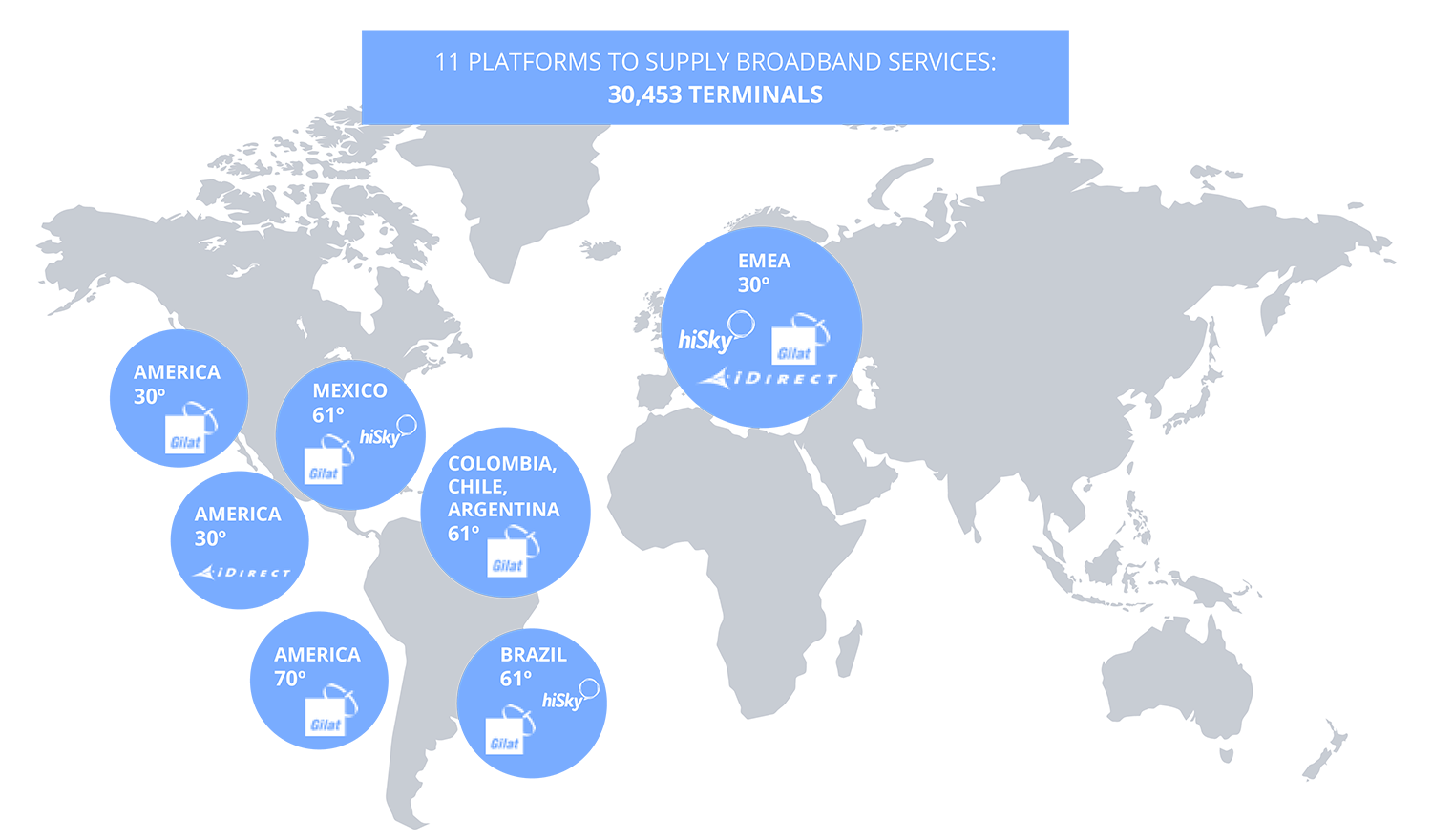SATELLITE FLEET
As of December 2019, HISPASAT has 9 satellites located in 6 orbit positions,
three control centres, 4 monitoring stations and 8 broadband gateways.
The advanced design, the HTS capacity and the versatility of the Amazonas Nexus make it the most efficient satellite in the HISPASAT fleet.
NEW MISSION: AMAZONAS NEXUS
In 2019 HISPASAT completed the definition of the mission and the process of requesting bids and awarding the supply contract for the Amazonas Nexus satellite. The manufacturer chosen was Thales Alenia Space, who will design and implement the mission on a Spacebus NEO200 platform with electric propulsion at every stage, this being the first satellite with these characteristics that HISPASAT will operate.
With an estimated life of 15 years, 20 kW of satellite power and a launch mass of 4.5 tonnes, the Amazonas Nexus will be placed in orbit in the second half of 2022.
The main new feature of the Amazonas Nexus is a latest generation Digital Transparent Processor (DTP), an essential technological innovation to enhance the geographic flexibility of the device when faced with subsequent changes in the initially proposed business scenarios.
Thanks to this element, the satellite’s payload will be digitally processed, offering the possibility to assign the required capacities in orbit at any time. This ability helps ensure that the satellite is solid in the face of changes in the communications market, both in terms of connectivity and data and in content broadcasting.
The new satellite will feature coverage over the entirety of the Americas, the North Atlantic corridor (a major aerial and maritime traffic area) and Greenland, and will allow the company to provide latest-generation telecommunications services in the Ku band. The Amazonas Nexus inaugurates a new generation of satellites in the HISPASAT fleet with an innovative architecture that also incorporates capacity in the Ka band to optimize communications between the gateways and the satellite. This feature allows it to multiply the
total throughput capacity for commercial use, thus greatly improving the unit cost for capacity compared to traditional satellites.
LANDING RIGHTS
Particular progress was made in 2019 to complete the landing rights for the Hispasat 74W-1 and Amazonas 5 satellites.
As well as renewing the licenses that had already been obtained, this year the company also got new authorisations and licenses related to the HISPASAT satellite fleet.
In addition, HISPASAT has participated in numerous public consultations in different countries to protect the frequency bands that it currently operates against possible new frequency allocations proposed by each regulatory body.
At the same time, and in view of the growth of current operators and the emergence of new ones, in 2019 the company intensified its analysis of documents published by the International Telecommunications Union (ITU) and its coordination activities with other operators and governments, with the aim of maintaining HISPASAT’s orbit spectrum resources.
In the same vein, the company has continuously searched for new opportunities for orbit spectrum resources, which may be useful within the framework of the company’s growth strategies.
HISPASAT holds licences or authorisations known as landing rights, whenever necessary, to operate in all those countries covered by its satellite fleet. This includes Western and Central European countries and North Africa.
SPACE CAPACITY OPERATIONS
SATELLITE NETWORK OPERATION CENTRES
The space capacity operation of the satellite fleet allows the allocation over time of the capacity contracted by each client, and takes place at the Payload Monitoring Control (PMC) centres. These act as Network Operations Centres that have 24/7 customer support, manage space capacity, carrier line-up/down, signal monitoring, interference detection, peak and pol, and service problem solving.
PMC has 24/7 operating centres in Arganda del Rey and in Rio de Janeiro, and remote measuring stations (CMS) on C, Ku and Ka frequency bands, located on the different coverage beams in Spain, Argentina, Brazil, Mexico and the United States. It also has baseband signal analysis systems, equipment for monitoring and analysing satellite telemetry, and tools to manage the allocation of space capacity, transmissions and configuration of payload (SIGO).
PMC has an office for occasional use (booking) of space capacity in order to provide these services in the short term.
PMC OPERATIONS
Operational relationships with the satellite operators Intelsat and Telesat, which occupy the orbital positions adjacent to those occupied by the HISPASAT fleet, were strengthened with the aim of controlling adjacent satellite interference (ASI), for which operative coordination is essential, since each operator must, in a coordinated fashion, identify the stations of customers that are generating or receiving interference possibly from another satellite.
In 2019 PMC acquired new licenses for the Kratos SATGuard tool, with the aim of reducing the resolution time for incidents caused by incorrect VSAT terminal settings. By doing so, PMC has broadened the range of types of networks that can be analysed (Hughes, Gilat, iDirect, etc.) from the Arganda operations centre, offering very valuable support to clients to help them in the difficult task of identifying poorly installed terminals that are causing problems in space capacity.
Development of the Operational Management System (SIGO) continued with a view to covering the new needs of clients arising from the services provided. In particular, online RF measurement capabilities were expanded with new ASI measurement functions and antenna alignment and polarisation.
A new baseband monitoring system (BMS) based on analysis of the MPEG frame of DVB-S/S2 carriers has also been launched. On the one hand, this system makes it possible to find out which TV and radio channels are being transmitted via HISPASAT. On the other hand, thanks to this new system and the algorithms developed in SIGO, it is possible to calculate the average Mbps consumption of the carrier and of the various TV and radio channels that make up the connection for invoicing certain “Pay as you grow” type services.
Over the course of the year, PMC equipment has been relocated in a planned fashion to the new DPC (Data Processing Centre) at the control centre, as part of the general project that involves all the centre’s operational hardware, to adapt it to the new organisational model, which is more modern, functional and secure.
Throughout 2019, the availability of space capacity across all the fleet satellites was 100%, which adds to the quality of service provided to clients.
BROADBAND OPERATION
In 2019, HISPASAT implemented a new broadband platform aimed at providing managed Ka band services in Chile, Colombia and Argentina. With this, at the end of the financial year, HISPASAT had 11 active platforms to supply broadband services covering Brazil, Mexico, South America and Europe, both on Ku band and Ka band.
In terms of HISPASAT customer service, in 2019 the company strengthened the structure of the Broadband team. This has made it possible to offer 24/7 customer support services 365 days per year for the first time.
In addition, in 2019 HISPASAT made the JIRA support tool available to its clients, in order to give them a unique, powerful and centralised support tool that improves response times and client incident solution times.
The availability of all the annual services by platform have been maintained at values above 99.5%.
RESIDENTIAL BROADBAND
In terms of residential broadband services, in 2019 there was significant growth, and the following projects are worthy of note:
- Mexico Connected Project: In 2019 the client Elara completed the roll-out of all 2,500 HISPASAT satellite Internet connectivity hot-spots for the Mexico Connected project. This project, promoted by the Mexican Government’s Communications and Transport Secretariat (Secretaría de Comunicaciones y Transportes – SCT) seeks to contribute to guaranteeing the constitutional right to broadband Internet access, facilitating Internet connectivity in public spaces that currently lack public connectivity such as schools, health centres, libraries, community centres and parks. Through the Mexico Connected project, an increasing number of students and teachers have access to broadband at their schools and universities; more and more doctors and medical personnel have connectivity in their clinics and health centres, and even more citizens can enjoy a free Internet connection in public spaces, like libraries and community centres.
- Well-being Project: During this financial year, HISPASAT started with Goblasat the tests, integrations and pilots for the subsequent deployment in 2020 of 4,000 and 8,000 new satellite Internet hot-spots will be deployed in specific isolated regions of Mexico that currently do not have such services. In 2019 the whole Broadband Engineering team, alongside Globalsat, was charged with validating the definitive operating scenarios through several pilot and demonstration phases, ready for deployment in 2020.
- Residential DISH service: HISPASAT worked with DISH in 2019 to adapt its operating procedures to broadband service provision, which made it possible to start growing the number of new hot-spots deployed at a good rate. It is also worth highlighting that all the optimisations carried out with DISH in terms of designing services based on smart-browsing configurations, allow end users of the service to have very flexible capacity consumption quota schemes depending on the applications that they are using at any time (web browsing, YouTube, e-mail, among others).
MOBILITY BROADBAND
In the field of mobility, in 2019 the company worked on updating the iDirect platform with a view to giving it the necessary capacity to configure global networks. This will allow the HISPASAT iDirect platform to be integrated with other third-party iDirect platforms and will mean that other external platform operators can integrate with HISPASAT’s iDirect platform. This new feature is key for creating global networks that are critical for the majority of maritime services, since vessels travel great distances and need to use different satellite coverage. With this objective in mind, HISPASAT has integrated its own platforms for Europe and America, creating a global iDirect network that allows for transparent roaming so that clients’ boats can move from European coverage to South American coverage and vice-versa, without having to reconfigure the satellite terminals on their ships.
Regarding the network of terminals deployed on Renfe’s high speed trains (AVE), this year, in coordination with Telefónica, work has been done to keep the terminal base available and to iron out some aspects to improve the solution, on both the integration with 3G traffic and the Multicast TV solution that is provided to passengers.
CORPORATE BROADBAND
In the corporate broadband arena, HISPASAT has managed to maintain a stable base of large clients and has also worked on new corporate projects. These have involved implementing ad-hoc IP engineering solutions and prioritising broadband platforms to ensure that solutions meet the special design specifications requested by clients. This is the case with Wibo, which from 2019 provide Internet services via HISPASAT to connect remote areas of Mexico on Ka band. A whole range of services adapted to their various needs and economic availability will be made available to users of this service, such that many citizens and small businesses in these localities that currently do not have digital connections will be able to enjoy the benefits of access to the global Internet network.
Work carried out with Facebook is also noteworthy. This has involved deploying WiFi hot-spots via satellite in various regions of Brazil, using HISPASAT’s satellite capacity and the Express WiFi platform by Facebook. These WiFi hot-spots will allow local Internet service providers to offer pre-paid data packages in areas that have limited resources and poor connectivity.
© Informe Anual Hispasat 2018
Paseo de la Castellana, 39 28046 Madrid Spain
+34 91 710 25 40








